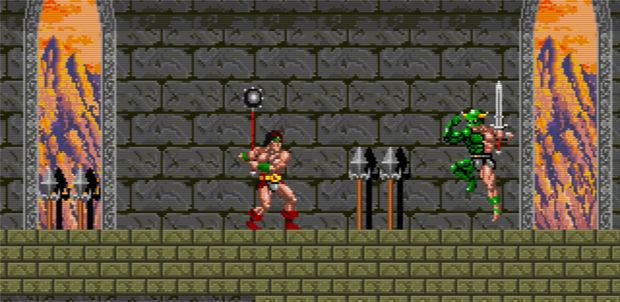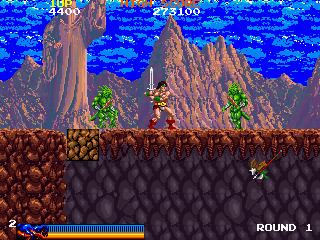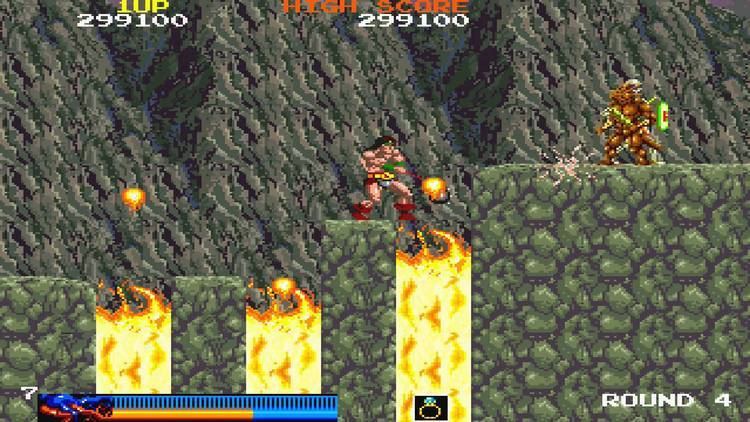9 /10 1 Votes
Director(s) Yoshinori Kobayashi Designer(s) Toshiyuki Nishimura | 4.5/5 My Abandonware Producer(s) Yoshinori Kobayashi Initial release date 1987 Sound Motorola 6809 | |||||||||||||||||||||||||||||||||
Programmer(s) Yoshinori KobayashiHideaki TomiokiTouru TakahashiHideo Kazama Artist(s) Toshiyuki NishimuraTaira SanukiSeiji KawakamiGenya Kuriki Composer(s) Naoto YagishitaMasahiko Takaki Platforms Arcade game, Master System, Commodore 64, MSX, ZX Spectrum, Game Gear, Amstrad CPC, DOS, Apple II, MSX2 Similar Taito games, Platform games | ||||||||||||||||||||||||||||||||||
Rastan Saga (ラスタンサーガ), released as Rastan outside of Japan, is a fantasy-themed side-scrolling action game originally released for the arcades in 1987 by Taito and later ported to various platforms. The player controls a barbarian warrior who has embarked on a quest to slay a dragon. While on his way to the dragon's lair, Rastan must fight hordes of enemy monsters based on mythical creatures such as chimeras and harpies.
Contents

Gameplay

The controls of Rastan consists of an eight-way joystick and two buttons for attacking and jumping. By using the joystick in combination with either buttons, the player can determine the height of Rastan's jumps, as well as the direction where There are a total six rounds, each consisting of three areas: an outdoor scene, a castle scene and a throne room where the player must confront the stage's boss. The backgrounds of the outdoor areas feature broad landscapes with changing sunlight effects with detail. The game's bosses (names according to the MSX2 version) consist of Graton (a skeletal warrior who wields a halberd), Slay (a demonic swordsman who can sprout wings), Symplegades (a wizard), Laios (a dragon knight), the Hydra (a five-headed snake) and the final boss, the Dragon.

The player can pick up any item by touching them, as well as new weapons by striking them with his current one. All the weapons and power-ups picked by Rastan will be equipped only for a limited time. When Rastan picks up any equipable item, an icon will appear on the lower right corner of the screen as an indicator of the item's effect until it wears out. Rastan can only wield one weapon at a time (which consists of a mace, an axe and a fireball-shooting sword in addition to his standard sword), as well as only one type of protector (a shield, a mantle or a body armor), but other items (such as the necklace and ring) can be worn at the same time. There are also jewels that gives out bonus points, as well potion bottles that will restore or deplete the player's health depending on the color. The rare golden sheep's head will restore Rastan's health completely.
Regional differences

Rastan Saga (the Japanese version) features an opening sequence, when the player starts the game, which explains the purpose of Rastan's journey. It is not included in the export versions (which were simply titled Rastan). Also, in the Japanese version when the player completes a stage ("Round") the "victory" screen has text pertaining to the storyline. In the overseas versions, there is a "generic" victory screen with generic text ("You are a brave fighter to have cleared such a difficult stage."). However, the overseas versions feature a different attract sequence which shows all the items that can be obtained by the player along with their effect.
In "Rastan Saga" there are far fewer bats during the bat swarm sequences in the castle of level 1 than in "Rastan."
Ports
Rastan was initially ported to various 8-bit home computers in Europe (the Commodore 64, ZX Spectrum and Amstrad CPC) by Imagine Software in 1988. The ZX Spectrum version was awarded 9/10 in the July 1988 issue of Your Sinclair and was placed at number 54 in the Your Sinclair's Top 100 list. Taito exported the C64 version to the United States in 1990, releasing it alongside two additional versions for the IBM PC and Apple IIGS.
A previously unreleased version for the Atari ST was discovered in demo form only
In 1988, Taito also developed its own conversions of Rastan for the MSX2 in Japan and the Master System in North America and Europe (both versions featured redesigned level layouts, with the Master System version replacing some of the boss characters as well). The Master System version was later ported to the Game Gear and released exclusively in Japan on August 9, 1991.
An emulation of the Rastan arcade game is included in Taito Legends Vol. 1, released for the PlayStation 2, Xbox and Windows PC in 2006.
Sequels and related releases
The game was followed by two sequels, Rastan Saga II (also known by two other names, Nastar in Europe and Nastar Warrior in North America) and Warrior Blade Rastan Saga Episode III. Rastan also made an appearance in another Taito game titled Champion Wrestler as "Miracle Rastan".
Saffire developed a 3D fighting game called Warrior Blade: Rastan vs. Barbarian for the PlayStation 2, and Nintendo GameCube that was released in 2003 by Taito in Japan, though the game title is the only relationship to Rastan Saga.
Indie game Völgarr the Viking, developed by Crazy Viking Studios for Windows, OS X, Linux, Xbox One, and Dreamcast, was described on its Kickstarter page as based on Rastan.
